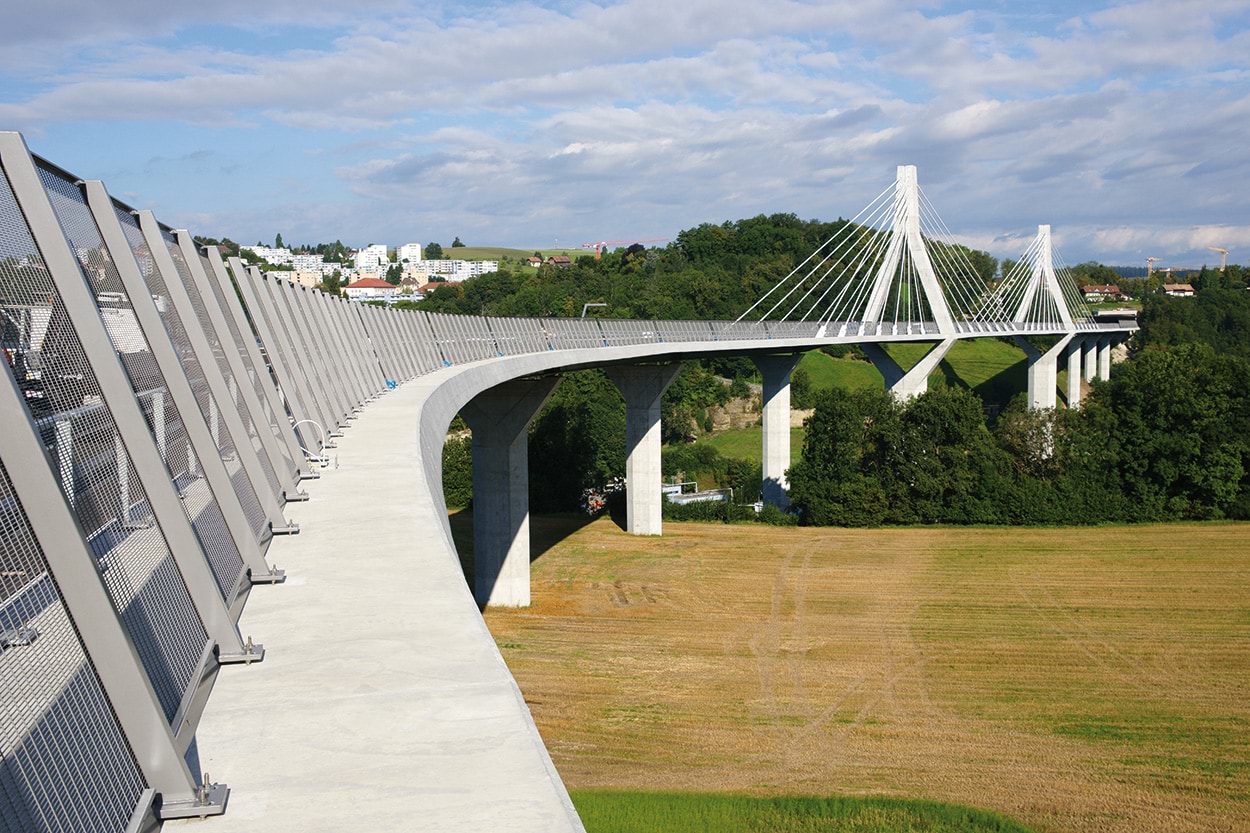
No more corrosion with galvanic anodes
What are the most common causes of corrosion in reinforced concrete structures and what can be done to stop or prevent it? Hadi Beirami explains to us how carbonation and chlorides are the two most frequent aggressive agents behind this degenerative process that can affect the structural stability of reinforced concrete members.
Cathodic protection, through either impressed current or the use of sacrificial anodes, helps prevent reinforced concrete from deteriorating and, particularly in the second case, allows us to reduce maintenance costs over the long term.
What are the most common causes of corrosion in reinforced concrete structures and what can be done to stop or prevent it? Hadi Beirami explains to us how carbonation and chlorides are the two most frequent aggressive agents behind this degenerative process that can affect the structural stability of reinforced concrete members.
THE MAIN CAUSES OF CORROSION
An increase in the level of damage caused by corrosion has opened new horizons in order to achieve the durability and the stability of reinforced concrete structures, especially in highly aggressive areas.
Various phenomena contribute to the onset of corrosion in steel reinforcement in concrete. In this article, we will discuss the most common causes of corrosion, with particular reference to carbonation and chlorides.
Because of its inherent alkaline nature, concrete creates a protective environment around the steel, but this environment is not eternal. Studies show that damage due to corrosion occurs when critical amounts of aggressive agents penetrate through the pores in the concrete, attack and destroy the passivation protective film around the steel and expose the reinforcement rods to the corrosion process.
There are two main types of aggressive agents that can create this phenomenon:
■ Carbonation: the carbon dioxide and moisture in the surrounding air penetrate into the pores of the concrete and lower the level of pH to values close to neutral. In such conditions the reinforcement rods may corrode;
■ Chlorides: by penetrating into the concrete, this type of aggressive agent might break the protective film and produce localised corrosion (pitting), including in alkaline conditions, that may even lead to a failure of the steel reinforcement.
Corrosion of reinforcement rods generated by these phenomena form iron oxide (Fe2O3). Since iron oxide (rust) is much more voluminous than solid steel (5-6 times more), even a small loss of metal (e.g. ~ 0.1 mm) from the surface of the reinforcement rods can cause sufficient corrosion products to generate internal stresses that crack and damage the concrete (Figure 1).
Chloride corrosion acts in a local and highly destructive way and is undoubtedly the most aggressive and dangerous type for the structural stability of a reinforced concrete element.
CATHODIC PROTECTION IS THE MOST EFFICIENT SOLUTION
According to a report by the Federal Highways Administration, an agency within the US. Department of Transportation, cathodic protection (CP) has proven to be the most effective technique to reinstate reinforced concrete structures contaminated by chlorides and stop corrosion, whatever their level [1]. By applying cathodic protection, the potential for corrosion is transferred towards a zone of immunity and the corrosion process is terminated. To apply cathodic protection, only the damaged part of the concrete needs to be removed and it is not always necessary to remove the solid, contaminated part.
The application of cathodic protection to a reinforced concrete structure transforms the surroundings around the reinforcement and produces a number of positive effects. Inside the concrete with cathodic protection, the current is transported by the ions in proportion to their concentration and mobility. The positive ions move in the same direction as the current, that is, from the anode to the cathode, whereas the negative ions move in the opposite direction. In so doing, the current flowing through the concrete contaminated by chlorides cause the chlorides (Cl-) to migrate from the area around the cathode (-) to the area around the anode (+). In such cases, the flowing current determines a reduction of the chloride content on the surface of the reinforcement rods, which is known as “dechlorination” (Figure 2a).
Also, oxygen and water on the surface of the reinforcement rods (cathodic zone) are consumed and form hydroxyl ions (2OH-) according to the equation:
H2 + ½ O2 + e- --> 2OH-
The hydroxyl ions restore the alkalinity of the surface of the metal to a pH level of up to around 12, known as the “re-alkalisation effect” (Figure 2b) and induce re-passivation of the reinforcement.
PREVENTION FOR NEW STRUCTURES
New structures situated in aggressive surroundings may be fitted with a CP system that is applied at the start of their service life. This type of protection is called “cathodic prevention” and may be used on new structures, or on existing structures in which the corrosion process has not initiated but is likely to occur due to the progressive penetration of aggressive agents over the months and years. In such cases, cathodic prevention may be applied very simply by using a low, continuous current sufficient to protect the structure and guarantee long-term protection that is also cost-effective if we consider the low level of current required for reinforcement rods that have already been passivated [2].
There are two types of cathodic protection: impressed current (ICCP) or galvanic with sacrificial anodes (SACP). When correctly designed, installed and put into service, both systems have proven to have the capacity to control or mitigate corrosion by providing the level of protection required. The main difference between the two systems is that the impressed current type requires a power supply and a source of electrical energy to make it work, whereas the galvanic system is based on the principle of two different metals joined together in the same surroundings that generate electrical energy, similar to a battery.
REDUCING MAINTENANCE COSTS AND UNFORESEEN EVENTS THANKS TO THE USE SACRIFICIAL ANODES
One of the main advantages of SACP is that it only requires a minimum level of maintenance once it has been installed. Also, since it does not require a source of electrical energy, the system is immune to interruptions in the current or a sudden failure of the power supply. What is more, galvanic systems use relatively low natural currents (the difference in natural potential between the sacrificial anode and the steel to be protected) which prevent the possibility of problems occurring due to hydrogen embrittlement and stress corrosion of pre-stressed steel, which could occur, on the other hand, in the case of high protection with ICCP systems. The simplicity of its design and the low level of maintenance required are seen, therefore, as the main advantages of SACP systems. In an SACP system the current is self-regulating according to the rate of corrosion of the steel reinforcement, which means the system functions as and when required and without being forced and without overloads [3].
An SACP system also has limits. The main operational limit is that galvanic systems have their own fixed, natural potential and, as a result, in heavily reinforced elements, the current generated may not always be sufficient to guarantee polarisation of the steel. In such cases, increasing the number of sacrificial anodes and using low resistivity mortar can be an effective solution. The service life of anodes in SACP systems is determined by various factors and these may vary as time goes by. The relationship between the anodic current that consumes the anode and the rate of corrosion, expressed as loss in mass over time, may be obtained by applying Faraday’s first law. The mass of anodic material required, which also includes efficiency and usage factors, is calculated by applying this law according to the equation:
W = (ARC * CR * L) / (E * U)
Where:
■ ARC is the average current required (typically from 2 to 20 mA/m2 for old structures and from 0.2 to 2 mA/m2 for new structures according to ISO 12696:2012 “Cathodic protection of steel in concrete”);
■ CR is the consumption rate of the anode;
■ L is the design life;
■ E is the efficiency of the metal used;
■ U is the usage factor of the anode used.
For example, if we consider a zinc anode generating a constant current of 1 mA for one year, the consumption rate would be around 12-14 g of anodic material.
Considering the standards for “Cathodic protection of steel in concrete” [4, 5], the most widely adopted criteria for assessing the performance of a CP system applied to a structure is to measure depolarisation starting from the potential "Instant OFF". In practical terms, the potential of the reinforcement rods with the anodes attached must be measured (polarisation), following which the anodes are disconnected from the reinforcement rods and the measurement is repeated. There will be depolarisation phenomenon that consists of an increase in the potential of the steel reinforcement to more positive values (e.g. polarisation -450mV; depolarisation -285mV). According to ISO 12696, this shift in potential must be at least 100 mV within a maximum of 24 hours or at least 150 mV over a longer period. A typical depolarisation graph is shown in Figure 3.
The instruments used to measure potential include manual or portable devices or ones that are installed permanently on the structure. The use of a permanent, online monitoring system is preferable because it allows data to be accessed at any time and also identifies problems immediately. For most important structures, inspections are generally carried out according to a set schedule that may vary from months to years, unless there are particular conditions that require more frequent inspections. It is to be hoped that, in the not too distant future, large infrastructures will be equipped with systems of this type in order to overcome safety problems, but also to monitor and gain a better understanding of the mechanisms associated with the deterioration of structures.
References
1- Scheffy, C. F. (1981). Bridge deck deterioration - A 1981 perspective. FHWA Memorandum, Federal Highway Administration Office of Research.
2- Pedeferri, P. (1996). Cathodic protection and cathodic prevention. Construction and building materials, 10(5), pp. 391-402.
3- Item No. 24224, (2005). Sacrificial cathodic protection of reinforced concrete elements. Houston, TX: NACE International.
4- ISO, B. (2016). 12696 -2016. Cathodic protection of steel in concrete.
5- SP0216 (2016). Sacrificial cathodic protection of reinforcing steel in atmospherically exposed concrete structures. Houston, TX: NACE International.












